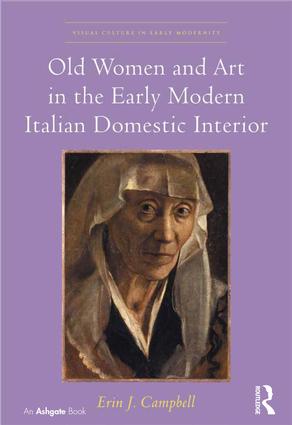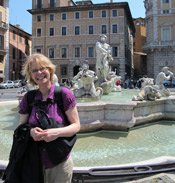Each year UVic faculty, staff, students, alumni, and retirees produce an incredible amount of intellectual content reflecting their breadth and diversity of research, teaching, personal, and professional interests. A list of these works is available here.
Old Women and Art in the Early Modern Italian Domestic Interior by UVic Associate Professor Erin J. Campbell explores the depiction of old women in 16th-century Italian art, considering both their purpose in art and their role in domestic life.
About the Book
Though portraits of old women mediate cultural preoccupations just as effectively as those of younger women, the scant published research on images of older women belies their significance within early modern Italy. This study examines the remarkable flowering, largely overlooked in portraiture scholarship to date, of portraits of old women in Northern Italy and especially Bologna during the second half of the sixteenth century, when, as a result of religious reform, the lives of women and the family came under increasing scrutiny. Old Women and Art in the Early Modern Italian Domestic Interior draws on a wide range of primary visual sources, including portraits, religious images, architectural views, prints and drawings, as well as extant palazzi and case, furnishings, and domestic objects created by the leading artists in Bologna, including Lavinia Fontana, Bartolomeo Passerotti, Denys Calvaert, and the Carracci. The study also draws on an array of historical sources – including sixteenth-century theories of portraiture, prescriptive writings on women and the family, philosophical and practical treatises on the home economy, sumptuary legislation, books of secrets, prescriptive writings on old age, and household inventories – to provide new historical perspectives on the domestic life of the propertied classes in Bologna during the period. Author Erin Campbell contends that these images of unidentified women are not only crucial to our understanding of the cultural operations of art within the early modern world, but also, by working from the margins to revise the center, provide an opportunity to present new conceptual frameworks and question our assumptions about old age, portraiture, and the domestic interior.
About the Author
Erin J. Campbell fell in love with Europe and the art of Titian, Caravaggio, and Rembrandt while studying art history at the University of Toronto. She spent part of her MA program at Kommos, Crete, under the direction of Joseph Shaw, excavating a Minoan road and cataloguing pottery and was  determined to pursue a career in Bronze Age archaeology. However, her keen interest in European art was rekindled during the PhD program by Philip Sohm, and while doing research in Venice, Florence, and Rome for her PhD dissertation on Italian art theory and criticism, she developed a passion for Italy that continues unabated. Today, her research takes her to museums, libraries, and conferences in Britain, Europe and North America, where she has been fortunate to meet scholars and students from around the world. An award winning teacher and researcher, Erin’s current research, on the Early Modern domestic interior, allows her to revive her love of archaeology and material culture by studying the objects that surrounded families during one of the most tumultuous periods in European history. Erin is an Associate Professor of the History of Art at the University of Victoria. She is also the editor of Growing Old in Early Modern Europe: Cultural Representations (Ashgate, 2006), and is a co-editor of The Early Modern Italian Domestic Interior, 1400-1700 (Ashgate, 2013).
determined to pursue a career in Bronze Age archaeology. However, her keen interest in European art was rekindled during the PhD program by Philip Sohm, and while doing research in Venice, Florence, and Rome for her PhD dissertation on Italian art theory and criticism, she developed a passion for Italy that continues unabated. Today, her research takes her to museums, libraries, and conferences in Britain, Europe and North America, where she has been fortunate to meet scholars and students from around the world. An award winning teacher and researcher, Erin’s current research, on the Early Modern domestic interior, allows her to revive her love of archaeology and material culture by studying the objects that surrounded families during one of the most tumultuous periods in European history. Erin is an Associate Professor of the History of Art at the University of Victoria. She is also the editor of Growing Old in Early Modern Europe: Cultural Representations (Ashgate, 2006), and is a co-editor of The Early Modern Italian Domestic Interior, 1400-1700 (Ashgate, 2013).
Praise for the Book
“This is a work of careful reconstruction, deep archival documentation, and sensitivity to the lived experience and material context of portraiture. Campbell proves that old women of the later Renaissance were far from invisible: especially in Bologna, they were pictured, commemorated, and their likenesses revered as symbols of family identity and tools of memory. Her work shows that portrayals of elderly women were not limited to witches, crones, or hags. Rather, old women’s roles of piety, authority, and virtue found expression in their portraits. These same vivid, striking portraits adorned family homes, shaping and re-shaping behavioral codes and family memory. This provocative, well-illustrated work will alter our understanding of the history of Renaissance portraiture, the Italian domestic interior, and patriarchy itself among the patrician class.” – Renée Baernstein, Miami University, Ohio
